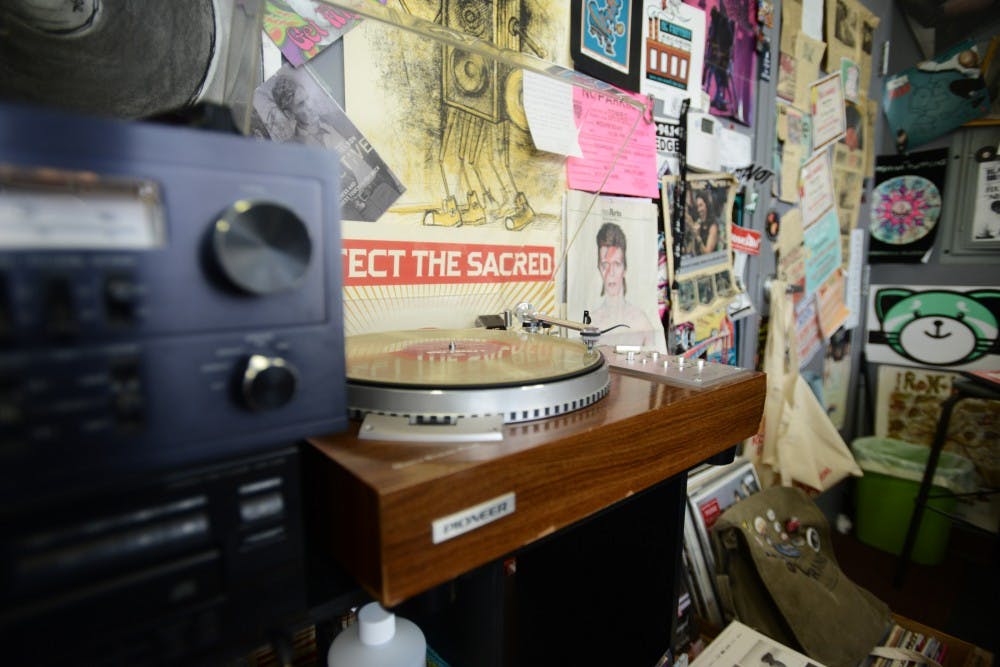In an era when newfangled music streaming services have contributed to the disintegration of albums and overall music purchasing is easily avoided, against all odds, vinyl culture paradoxically thrives and prospers.
The only form of music acquisition that requires investment in an entire musical collection, let alone one that is bulky, potentially losable, not preserved in some immortal, intangible “cloud,” has experienced ten straight years of growth, according to Nielsen, a company that tracks the sale of music.
“I think it’s that [record purchasers] want something from back in the day,” Heather Frarey, owner of The Record Lounge on Division Street, said about her college-aged audience. “You know, people say ‘hipster,’ but they want that something cool, something tangible that their parents had.”
That was certainly the case for Johnny Dodge, a junior at MSU. For Dodge, a music aficionado irrespective of genre or time period, his baptism into the vinyl congregation came from beneath the flaps of a proverbial tucked-away, dust-blanketed cardboard box in his childhood basement.
“I was digging around in my parents’ basement one day, and I found some of these old records,” Dodge said, instantly drawn to the sleeved disks. “And I’ve always been like kind of into the older music. And I found some older bands that I knew so I was like, ‘Mom, Dad, do we have something to play this with?’
“And we didn’t. So I hit my grandpa up, and he let me borrow his (record player) for the time being. And it all just kind of snowballed from there.”
Dodge, a vinyl collector with upwards of a quarter of a thousand records, says that it’s no longer simply the music traditionalists who promote the move to turntables and needles.
“You know, as much flack as hipster culture gets, hipster culture is mainstream culture,” Dodge said, crediting “hipsters” for pioneering the revitalization of vinyl.
In the 1990s and early 2000s, with compact discs on the market, records were subsidiary and obsolete. But the matriculation of millennials into the vinyl community resulted in the recirculating of records from the past, bucking the foreboding death of vinyl.
The redevelopment of record culture has behooved independent record stores like The Record Lounge more than any other party, as nationally, independent record stores were responsible for 45% of vinyl transactions. The refusal of records to die off is a conscious effort from vinyl producers and distributors, according to Frarey.
“You get a download with an album if it’s a new one, nowadays,” Frarey said to provide an example.
Meanwhile, Dodge argued that even in the dimmer moments of record popularity, vinyl was still the superior method for music enjoyment. It just needed the right generation to appreciate it.
“It never really stopped being cool. Just one day, somebody got the idea that we could still do it, and it came back,” Dodge said.
Both Dodge and Frarey list sound quality as one of the main two factors in vinyl’s resurrection.
“With digital recordings, you’ll see a bit rate next to the file, and basically the higher the bit rate, the more little samples it takes in every second,” Dodge said. “If you’ve ever looked at a sound wave, it’s just that etched into the grooves of the vinyl and the needle reads that, so you don’t have clips.”
Frarey simplified the science.
“Vinyl in general sounds a lot better,” Frarey said.
Yet, the discrepancy of sound is not what it used to be, according to Dodge. Because sometimes the only discernible improvement can be heard with expensive equipment, even more important in vinyl’s revival might be the library-esque amalgam of diverse colors and covers that impressively cloak every record.
“However, these (sound differences) are so minute... and I know that there have been blind studies where people can’t tell the difference,” Dodge said, continuing to state that advancing digital technology had almost caught up in sound quality. “But for aesthetic purposes, [vinyl] definitely looks cooler.”
Frarey also noted how colored vinyl had enhanced the ocular element of record-listening to another level, proudly boasting of a holographic Star Wars soundtrack that under the light displayed the movie’s staple Millennium Falcon spaceship flying around the center.
However, for both Frarey and Dodge, neither sound quality nor artistic extolment fully explained the allure of records; for them, there was an ineffable aspect in vinyl culture that made it so much more than a music-listening experience. In many ways, vinyl-collecting was admission to an exclusive cult of music lovers.
“It’s almost like a ritual, just putting the needle onto the wax,” Dodge said, searching for words to describe the experience. “It’s a little more primitive but a little more traditional and, I don’t know, a little more right.”







